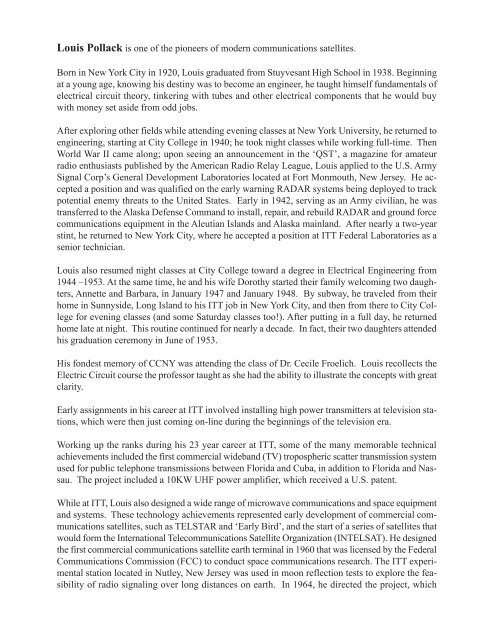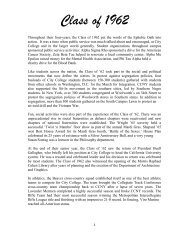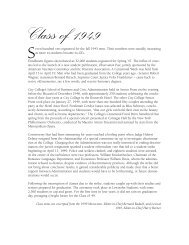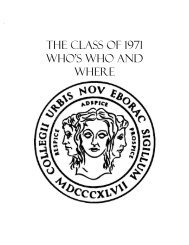Louis Pollack is one of the pioneers of modern communications satellites.Born in New York <strong>City</strong> in 1920, Louis graduated from Stuyvesant High School in 1938. Beginningat a young age, knowing his destiny was to become an engineer, he taught himself fundamentals ofelectrical circuit theory, tinkering with tubes and other electrical components that he would buywith money set aside from odd jobs.After exploring other fields while attending evening classes at New York University, he returned toengineering, starting at <strong>City</strong> <strong>College</strong> in 1940; he took night classes while working full-time. <strong>The</strong>nWorld War II came along; upon seeing an announcement in the ‘QST’, a magazine for amateurradio enthusiasts published by the American Radio Relay League, Louis applied to the U.S. ArmySignal Corp’s General Development Laboratories located at Fort Monmouth, New Jersey. He accepteda position and was qualified on the early warning RADAR systems being deployed to trackpotential enemy threats to the United States. Early in 1942, serving as an Army civilian, he wastransferred to the Alaska Defense Command to install, repair, and rebuild RADAR and ground forcecommunications equipment in the Aleutian Islands and Alaska mainland. After nearly a two-yearstint, he returned to New York <strong>City</strong>, where he accepted a position at ITT Federal Laboratories as asenior technician.Louis also resumed night classes at <strong>City</strong> <strong>College</strong> toward a degree in Electrical Engineering from1944 –<strong>1953</strong>. At the same time, he and his wife Dorothy started their family welcoming two daughters,Annette and Barbara, in January 1947 and January 1948. By subway, he traveled from theirhome in Sunnyside, Long Island to his ITT job in New York <strong>City</strong>, and then from there to <strong>City</strong> <strong>College</strong>for evening classes (and some Saturday classes too!). After putting in a full day, he returnedhome late at night. This routine continued for nearly a decade. In fact, their two daughters attendedhis graduation ceremony in June of <strong>1953</strong>.His fondest memory of CCNY was attending the class of Dr. Cecile Froelich. Louis recollects theElectric Circuit course the professor taught as she had the ability to illustrate the concepts with greatclarity.Early assignments in his career at ITT involved installing high power transmitters at television stations,which were then just coming on-line during the beginnings of the television era.Working up the ranks during his 23 year career at ITT, some of the many memorable technicalachievements included the first commercial wideband (TV) tropospheric scatter transmission systemused for public telephone transmissions between Florida and Cuba, in addition to Florida and Nassau.<strong>The</strong> project included a 10KW UHF power amplifier, which received a U.S. patent.While at ITT, Louis also designed a wide range of microwave communications and space equipmentand systems. <strong>The</strong>se technology achievements represented early development of commercial communicationssatellites, such as TELSTAR and ‘Early Bird’, and the start of a series of satellites thatwould form the International Telecommunications Satellite Organization (INTELSAT). He designedthe first commercial communications satellite earth terminal in 1960 that was licensed by the FederalCommunications Commission (FCC) to conduct space communications research. <strong>The</strong> ITT experimentalstation located in Nutley, New Jersey was used in moon reflection tests to explore the feasibilityof radio signaling over long distances on earth. In 1964, he directed the project, which
proposed the design of communications transponders installed in the INTELSAT III satellite series,helping to establish the worldwide telecommunications services of INTELSAT.Reaching the position of Director of Transmission Systems Operations at ITT, he was offered newopportunities with the Communications Satellite Corporation (COMSAT) in Washington, DC whenhe moved his family to Rockville, Maryland in 1967.At COMSAT, he initiated and gave technical leadership to many advances in space communicationsand microwave technologies leading to improved satellite reliability, increased communicationscapacity, and decreased spacecraft weight and power consumption. He was one of the original organizersof COMSAT Laboratories and established the Microwave Lab. In the early 1970’s, Louisbegan development of multi-beam antennas; these designs permitted increased bandwidth to beavailable to satellite systems and were the basis for the INTELSAT V and INTELSAT VI satelliteantenna specifications. Additionally, he designed and tested an Unattended Earth Terminal with aunique multi-beam torus antenna communicating simultaneously with several satellites. This developmentresulted in one of several patents awarded during his career, contributing to innovativesatellite and earth station systems design.He was appointed Executive Director of COMSAT Laboratories in 1978 with responsibility for allresearch and development activities at COMSAT. In 1980, he was appointed Vice-President ofCOMSAT World Systems Division, where he was responsible for the INTELSAT Technical Servicesdivision comprised of 140 engineers.Louis retired from COMSAT in 1984, 44 years after a pioneering journey in microwave equipmentdesign and communications satellite development. He is still an active Fellow of the Institute ofElectrical and Electronic Engineers (IEEE); he has been a member of IEEE since 1944 from thetime the professional organization was known as the IRE, Institute of Radio Engineers. He waselected ‘Fellow’ in February 1966 with the following citation: “For the pioneering design and developmentof communication satellite earth terminals, employed in moon reflection relaying”. Healso remains an Associate Fellow of the American Institute of Aeronautics and Astronautics (AIAA)and is an elected member of Sigma Xi. Louis has published many papers in the communicationssatellite and microwave fields, appearing in COMSAT Technical Review, IEEE journals includingthe IEEE Microwave Journal, Science and Wireless World, and others.Not feeling that it was time to truly ‘retire’, he founded Louis Pollack Associates, a satellite systemsengineering consulting firm specializing in communications satellite systems including earth stationdesign.In between consulting jobs, he and his wife Dorothy have spent many happy days (and weeks)traveling and enjoying the amenities of cruise ships, visiting destinations such as the Panama Canal,Alaska, Canada, and numerous ports of call throughout the Caribbean.Having recently celebrated 68 years of marriage, Louis & Dorothy reside in Rockville, Marylandand enjoy frequent visits from their son Larry, who lives nearby in Springfield, Virginia. Lou, at92, continues to tinker in his workshop in the same house he & Dorothy moved to in 1967.
- Page 3 and 4:
I think of the Main Building in ear
- Page 5 and 6:
HAROLD ADELSON, Ph.D.Liberal Arts &
- Page 7 and 8:
Alfred Baker: majored in mechanical
- Page 9 and 10:
public school career, was: “It do
- Page 11 and 12:
and especially to those who taught
- Page 13 and 14: Judge Herman Cahn, B.A., J.D.: was
- Page 15 and 16: the BSS degree. I sat in Dean Gotts
- Page 17 and 18: shook hands on the appointment, but
- Page 19 and 20: Elaine M. David, M.S.Ed.: studied E
- Page 21 and 22: William G. Drinnan, B.C.E., P.E.: I
- Page 23 and 24: Meanwhile, I was active in communit
- Page 25 and 26: Arthur Freed, B.C.E., P.E., F.N.SPE
- Page 27 and 28: Bernard Jack Gershen, B.E.E., M.S.E
- Page 30 and 31: Norah and I have two daughters and
- Page 32 and 33: Harvey Philip Greenspan, B.S., M.S.
- Page 34 and 35: Ramon Held, B.A., L.L.D.: was a law
- Page 36 and 37: Herbert Hershfang, B.A.: My most vi
- Page 38 and 39: graduate of CCNY. After 56 years, w
- Page 40 and 41: Herb Isaacs: My mother called me He
- Page 42 and 43: David M. Jacobowitz, B.S., M.S., Ph
- Page 44 and 45: I am a Past-President and long-time
- Page 46 and 47: Jerry N. Koral, B.S., Ph.D.: Jerry
- Page 48 and 49: -drolysis pilot plants and built tw
- Page 50 and 51: Fred Lipschitz, Ph.D.: I received m
- Page 52: At Jackson and Tull in Maryland, th
- Page 57 and 58: -sition he held for seven years and
- Page 59 and 60: Paul M. Parker: I was born in 1928
- Page 61 and 62: I was employed as an engineer at th
- Page 63: Edward S. Plotkin, B.E., M.B.A., P.
- Page 67 and 68: labs in New York City. He said “N
- Page 69 and 70: ›son), Brigadoon (Charley Dalrymp
- Page 71 and 72: A moment at City stands out in Bern
- Page 73 and 74: -gram, as I couldn’t take the sam
- Page 75 and 76: Eugene Sklar: I was born and raised
- Page 77 and 78: Jerry Somerdin, B.S., M.A: was a ma
- Page 79 and 80: Dr. Herbert Weissbach: I graduated
- Page 82 and 83: Professor Stanley A. Wolpert, B.A.,






